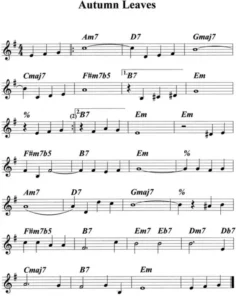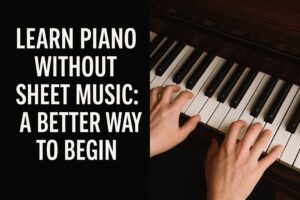 You can spend over a decade studying piano, mastering Beethoven sonatas and Debussy preludes, and still be completely mystified by a lead sheet. It’s something I see regularly—brilliant classical players who can sight-read anything with two staves and a time signature suddenly freeze when I hand them a single melodic line with chord symbols. That’s why this post is dedicated to helping you learn how to play piano from a lead sheet—a skill that unlocks creativity, freedom, and a whole new musical identity.
You can spend over a decade studying piano, mastering Beethoven sonatas and Debussy preludes, and still be completely mystified by a lead sheet. It’s something I see regularly—brilliant classical players who can sight-read anything with two staves and a time signature suddenly freeze when I hand them a single melodic line with chord symbols. That’s why this post is dedicated to helping you learn how to play piano from a lead sheet—a skill that unlocks creativity, freedom, and a whole new musical identity.
13 Years of Experience, Zero Lead Sheet Confidence
A woman once walked into my studio with around 13 years of classical piano training under her belt. She could tear through advanced repertoire—Beethoven, Chopin, Rachmaninoff, even some Bartók. I placed a lead sheet in front of her—just melody and chord symbols (similar the one above) and asked how she’d begin. Her shoulders dropped. She gently shook her head. “I have no idea what to do,” she said.
This isn’t unusual. And it’s not a sign of musical weakness—it’s a reflection of a very different mindset. Classical training focuses on exactitude: every note, every rhythm, every dynamic is written out and followed. Lead sheets, on the other hand, invite invention. You’re not just following instructions—you’re creating sound from structure.
What Is a Lead Sheet, Anyway?
A lead sheet is a streamlined way to notate music. It typically contains:
- A single melody line (often in treble clef)
- Chord symbols written above the staff
- Lyrics below the melody (if it’s a vocal tune)
Instead of telling you exactly what to play with both hands, it gives you freedom to craft the arrangement. This makes it ideal for jazz, pop, worship, and improvisational settings.
Why Classical Pianists Struggle with Lead Sheets
Many classical players view lead sheets like an unfinished puzzle. They see the melodic line, maybe even recognize some chord symbols, but have no system for interpreting them. That’s often because their own teachers weren’t trained this way either. It’s a cycle of interpretation without improvisation.
But to jazz musicians, a lead sheet is not a puzzle—it’s a playground. That G7 chord? That’s an opportunity. Those blank measures? That’s your moment to shine.
How to Play Piano from a Lead Sheet: Step-by-Step
Here’s a simple yet powerful process to get you started reading and interpreting lead sheets effectively:
- Play the melody: Use your right hand to play the melody as written. Don’t rush. Make sure you internalize the rhythm and phrase structure.
- Read the chord symbols: Each chord tells you what harmony to supply. Start with major and minor triads, and expand later into seventh and extended chords.
- Add root position chords: Use your left hand to play block chords that match each symbol. C, G7, Fmaj7—keep it simple at first.
- Experiment with comping: Add rhythmic interest. Try stabs, rolls, or even just alternating the root and chord in time. Think of your left hand as a rhythm section.
- Embellish the melody: Once confident, try adding grace notes, arpeggios, or fills to the melody line. Express yourself!
- Use inversions and voicings: Don’t stay in root position. Try second inversion chords, drop 2 voicings, or shell chords to create more colorful, professional textures.
A New Mindset: Interpretation vs. Creation
Switching from fully notated sheet music to a lead sheet isn’t just a technical leap—it’s an emotional one. You stop asking “What did the composer want?” and start asking “What can I bring to this moment?” There’s no longer a “correct” answer. Instead, there are choices. Musical ones. Personal ones.
The Power and Purpose of Lead Sheet Playing
Once you learn how to play from lead sheets, your musical world expands dramatically. You’ll be able to:
- Play in pop bands, jazz combos, or worship teams
- Play cocktail piano confidently
- Accompany singers with confidence and flair
- Improvise intros, interludes, and endings
- Compose your own pieces with a clear harmonic foundation
- Understand how songs are built, not just how they’re played
You’ll also feel more confident in jam sessions, at open mics, or even when casually noodling around on the piano.
Get Started Today
If lead sheets scare you, that’s okay. Start with simple songs—”Let It Be” by The Beatles, or “Lean On Me.” Play the melody. Try a few chords. Focus on feel rather than perfection. You’ll gradually build fluency—and find a new dimension of your musical self.
Dive into Some Lead Sheets
Ready to embark on this creative journey? Grab yourself a copy of the Real Book and start exploring. Choose a tune that speaks to you. Learn a handful of chords, then let your right hand sing the melody while your left hand breathes life into the harmony.
The next time someone hands you a lead sheet, don’t panic. Smile. You’re not facing a riddle—you’re holding an invitation to play, to explore, and to grow.

 Yes, it really is possible to learn piano with sheet music. If you’ve ever dreamed of playing piano but felt blocked by the idea of reading sheet music, you’re not alone. For many adults, the thought of going back to “Mary Had a Little Lamb” and decoding notes on a staff feels more like homework than music.
Yes, it really is possible to learn piano with sheet music. If you’ve ever dreamed of playing piano but felt blocked by the idea of reading sheet music, you’re not alone. For many adults, the thought of going back to “Mary Had a Little Lamb” and decoding notes on a staff feels more like homework than music.
 If you love playing standard songs on the piano but find yourself stuck using the same basic chords, you’re not alone. Many aspiring pianists wish to elevate their sound but don’t know how to transition from simple chords to professional-sounding harmonies. This is where understanding piano chord voicings comes in.
If you love playing standard songs on the piano but find yourself stuck using the same basic chords, you’re not alone. Many aspiring pianists wish to elevate their sound but don’t know how to transition from simple chords to professional-sounding harmonies. This is where understanding piano chord voicings comes in. Are you considering taking piano lessons but feeling intimidated by the thought of learning online? You’re not alone! Many prospective students worry that online lessons might be complicated or lack the personal touch of in-person sessions. However, these easy online piano lessons can be a straightforward and enjoyable way to start your musical journey.
Are you considering taking piano lessons but feeling intimidated by the thought of learning online? You’re not alone! Many prospective students worry that online lessons might be complicated or lack the personal touch of in-person sessions. However, these easy online piano lessons can be a straightforward and enjoyable way to start your musical journey. When considering piano lessons, it’s understandable to be drawn to the traditional, in-person studio experience. However, with decades of experience coaching piano students in both studio and online environments, I can confidently say that online piano lessons offer unique advantages that are hard to ignore. Let’s explore how online lessons can provide convenience, flexibility, access to quality instruction, and a focus on personalized creativity—all from the comfort of your home.
When considering piano lessons, it’s understandable to be drawn to the traditional, in-person studio experience. However, with decades of experience coaching piano students in both studio and online environments, I can confidently say that online piano lessons offer unique advantages that are hard to ignore. Let’s explore how online lessons can provide convenience, flexibility, access to quality instruction, and a focus on personalized creativity—all from the comfort of your home. Welcome to this very easy piano tutorial which is not likely what you would expect. The main goal here is to have fun and feel totally free while playing the piano. If you’ve ever felt hesitant or anxious about playing, this post is for you! Let’s dive into how you can embrace a nonjudgmental approach to tickling those ivories and truly enjoy the experience.
Welcome to this very easy piano tutorial which is not likely what you would expect. The main goal here is to have fun and feel totally free while playing the piano. If you’ve ever felt hesitant or anxious about playing, this post is for you! Let’s dive into how you can embrace a nonjudgmental approach to tickling those ivories and truly enjoy the experience. When I first considered offering piano lessons via Zoom, I admit I had my doubts. Would the interaction be too impersonal? Could I effectively teach and connect with my students through a screen? These were valid concerns, especially when traditional face-to-face lessons had been the norm for so long.
When I first considered offering piano lessons via Zoom, I admit I had my doubts. Would the interaction be too impersonal? Could I effectively teach and connect with my students through a screen? These were valid concerns, especially when traditional face-to-face lessons had been the norm for so long. As a pianist, I’ve worn many hats—performing at private parties, weddings, cruise ships, and even making brief appearance on television. But here’s the twist: I wasn’t the poster child for discipline and practicing piano was often optional. Instead, I followed my heart, playing what moved me, when it moved me.
As a pianist, I’ve worn many hats—performing at private parties, weddings, cruise ships, and even making brief appearance on television. But here’s the twist: I wasn’t the poster child for discipline and practicing piano was often optional. Instead, I followed my heart, playing what moved me, when it moved me.
 If you’ve ever felt a twinge of regret for abandoning piano lessons years ago, or if you’ve always harbored a secret desire to play but never got around to it, you’re not alone. Many adults find themselves in similar shoes, contemplating whether they should take the plunge into piano lessons. If you’re like most, you might have hesitated because you associate lessons with the tedious memories of your childhood – hours spent on theory, drills, and the pressure of being judged for not practicing enough. It’s time to dispel those fears and embrace a new approach to learning the piano.
If you’ve ever felt a twinge of regret for abandoning piano lessons years ago, or if you’ve always harbored a secret desire to play but never got around to it, you’re not alone. Many adults find themselves in similar shoes, contemplating whether they should take the plunge into piano lessons. If you’re like most, you might have hesitated because you associate lessons with the tedious memories of your childhood – hours spent on theory, drills, and the pressure of being judged for not practicing enough. It’s time to dispel those fears and embrace a new approach to learning the piano.